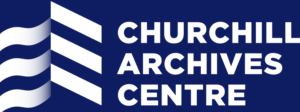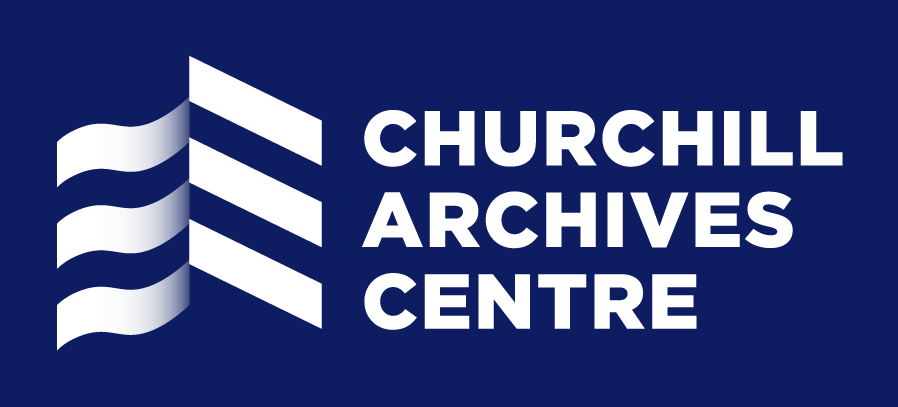Top Ten Collections: Partners and Secretaries
Documentary evidence that behind every great man there is at least one great assistant.
The papers of the women who organised and contributed towards their husbands’ and fathers’ work, or who were employed as secretaries, can often shed new light on twentieth-century science, politics, and culture.
Part of a series exploring women’s personal papers in the Churchill Archives Centre’s collections, these lists are not exhaustive and provide a very subjective window onto some of our personal highlights.
10 Phyllis Willmott (1922-2013)
After working as a bank clerk, then in the Women’s Auxiliary Air Force (WAAF) during WWII, Phyllis trained as a medical social worker. She gave up her career to raise a family when she married the sociologist Peter Willmott in 1948. She later built a career as a sociologist and lecturer on social policy in her own right, as well as a research assistant to Richard Titmuss and for the Institute of Community Studies. She kept a detailed diary from 1938 until her retirement.
Highlights:
- WLMT 1/10: Willmott’s reflections on her work as a medical social worker, and on her family life in Hackney with Peter Willmott and her young children, c. 1950s
- WLMT 2/2/2-6: correspondence between Willmott and her friend Winifred Pluckrose, written when the two women were engaged in war work, c. 1943-1945
9 Sasha Moorsom Young (1931-1993)
Sasha Moorsom was one of the BBC’s first women producers, and helped to introduce the work of Philip Larkin, Jean Rhys, and Ted Hughes to wider audiences through her work creating documentaries and dramas. In 1958, she invited Michael Young and Peter Willmott to turn their seminal work Family and Kinship in East London into a radio programme, and shortly afterwards embarked on an affair with Young. She left the BBC when she married, and combined raising two children with work as a writer and translator. She also later collaborated with her husband on various projects, including editing the magazine Where?, a companion to his consumer magazine Which?.
Highlights of the Sasha Moorsom Young Papers:
- YONG 4/1/3: original BBC script for ‘Families on the Move by Michael Young and Peter Willmott’, 14 May 1958
- YONG 2/1-3: love letters from Michael Young, c. 1958
8 Minna O’Conor (1865-1933)
Minna accompanied her husband Nicholas O’Conor, on his various diplomatic postings, including to China, the United States, Russia, and Turkey, from 1887 to 1908, during which she kept diaries and travel journals; wrote novels and poetry; and kept an archive of press cuttings on her husband’s career.
Highlights:
- OCON 13: Minna O’Conor’s unpublished literary works
7 Agnes Headlam-Morley (1902-1986)
Headlam-Morley became the first woman to hold a full professorship at Oxford, when she was appointed Montague Burton Professor of International Relations in 1948. She had been a tutor in modern history and fellow of St. Hugh’s College since 1932, specializing in Anglo-German relations. She devoted much of her career to assisting her relatives, including her cousin, uncle, and father, Sir James Headlam-Morley, the esteemed diplomatic historian, whose writings she edited for publication. Her papers include unpublished manuscript works and correspondence, and are currently in the process of being re-catalogued.
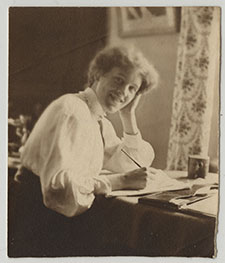
6 Adeline Hankey (1882-1979)
Born and raised partly in South Africa, Adeline studied at Brighton Art School, where she trained to become an art teacher. She married Maurice Hankey, a naval intelligence officer, in 1903, and thereafter devoted herself to raising their four children. Maurice Hankey became the first Cabinet Secretary in 1916, and Adeline played a supportive role in his career, accompanying him to the Paris Peace Conference in 1919. She also acted as an amanuensis for her husband, handwriting his famously detailed daily diary (also held at the Churchill Archives Centre) from 1915.
Highlights:
- AHKY 1/1: Correspondence between Maurice and Adeline Hankey, c. 1903-39
- AHKY 5/2: Adeline’s notes for speeches on nutrition during WWII
5 Anne Seagrim (1914-2011)
After training at secretarial college in London, Seagrim worked as a secretary at ICI, then at a company which tested ways of refueling aircraft in flight and researched radar installations on fighter planes during WWII. In 1944, she became private secretary to C. P. Snow at the English Electric Company, where she helped to set up the personnel department. She formed a close, lifelong working and personal relationship with Snow, reading and typing up the manuscripts of his novels and book reviews. Between 1950 and 1954, she was employed as private secretary to the Duke and Duchess of Windsor, dealing with their literary, business, and social affairs, and also supervising the decoration of their houses in France. In 1965, she was appointed administrator of the Winston Churchill Memorial Trust.
Highlights:
- SEAG 3/30: early letters from C.P. Snow to Anne Seagrim, c. 1944-47
- SEAG 1/1: ‘journal’ letters from Anne Seagrim to her family, including her first impressions of the Duke and Duchess of Windsor, and their other staff, c. 1950-51
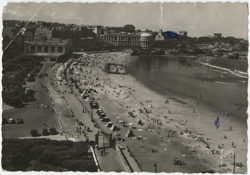
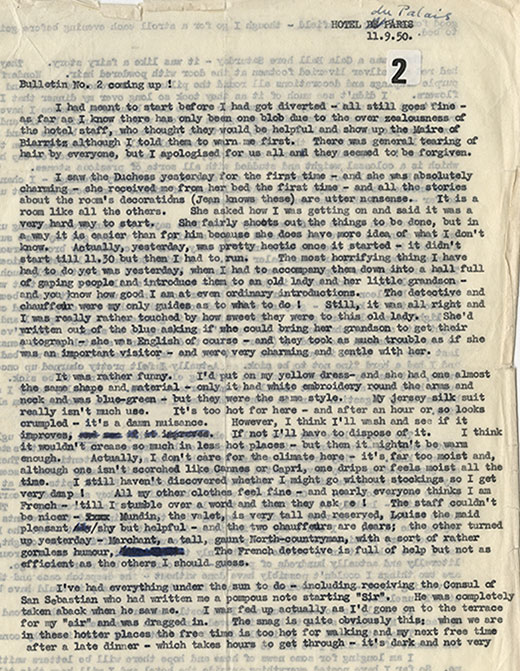
4 Vanda Salmon (1925-2009)
Salmon was employed as a secretary from 1947 by Conservative Central Office and the Conservative Research Department. She was then seconded to Winston Churchill’s office in 1950-51, before becoming a secretary to Nancy, Viscountess Astor, the first woman MP, and various other MPs and Peers.
Highlights:
- SALM 1/1B: Salmon’s scrapbook containing letters and photographs relating to her work as a secretary at Westminster, c. 1940-87
- SALM 2/5: draft of Salmon’s unpublished memoir, ‘Not in Hansard’ (undated)
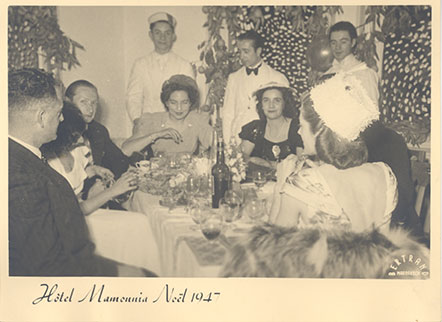
3 Nina, Lady Onslow (c.1920-2006)
Nina “Jo” Sturdee, later Lady Onslow, served as Personal Secretary to Winston Churchill from 1941-45, and as his Principal Private Secretary from 1945-53. She accompanied Churchill on many of his overseas visits, including waiting on him during the second Quebec and Yalta Conferences. In 1946, she typed up the famous ‘Sinews of Peace’ (Iron Curtain) speech which Churchill delivered in Missouri. Sturdee later became head of Churchill’s Private Office, taking responsibility for all his private correspondence.
Highlights of the Lady Onslow Papers:
- ONSL 1-4: letters and photographs sent from Sturdee to her family with descriptions of working as part of Churchill’s entourage during and after WWII
2 Grace Hamblin (1908-2002)
Hamblin was made a secretary at the Churchills’ family home, Chartwell, in Kent at the age of 24. During the 1930s she worked with Churchill on his history of the life of his ancestor, the 1st Duke of Marlborough. She became Personal Secretary to Clementine Churchill in 1939, and accompanied her to the first Quebec Conference and to Russia, where Clementine was head of the Red Cross Aid to Russia Fund. In 1965, Hamblin became the first administrator of Chartwell for the National Trust.
Highlights:
- HAMB 1/2: Hamblin’s notes for a speech on her ‘Chartwell Memories’, c. 1987
- CHWL 1-6: Hamblin’s papers relating to the administration of Chartwell, including correspondence and other notes on the interiors, gardens, and estate, c. 1929-76
1 Ruth Winawer (b.1910?)
Winawer had worked for seven years in the Features Department at the BBC, where she was Production Secretary to Louis MacNeice, before applying for the post of Private Secretary to Ove Arup, Consulting Engineer. Arup initially turned her down: “very cultured and rather left wing intellectual: I fear that the job is a little too mundane for her”. She went on to become his valued executive assistant, directing operations at Arup’s UK offices while he worked on research and engineering projects around the world. She later organised his personal papers and their transfer to the Churchill Archives Centre. Winawer’s letters to Arup are full of warmth and wit, and as well as their tales of office politics, give a fabulous insight into life as a working mother in North London during the 1960s and 70s.
Highlights:
- ARUP 2/108/2: correspondence between Ruth Winawer and Ove Arup during his visit to the United States as a visiting lecturer in the Graduate School of Design at Harvard, including Arup’s ‘reports’ for Ruth and her advice on life in the USA
- ARUP 2/108/4-6: correspondence between Ruth Winawer and Ove Arup during the Sydney Opera House project, c. 1957-67
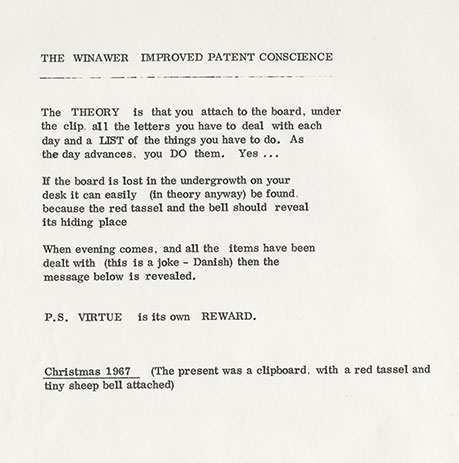
— Heidi Egginton, Archives Assistant, January 2022
